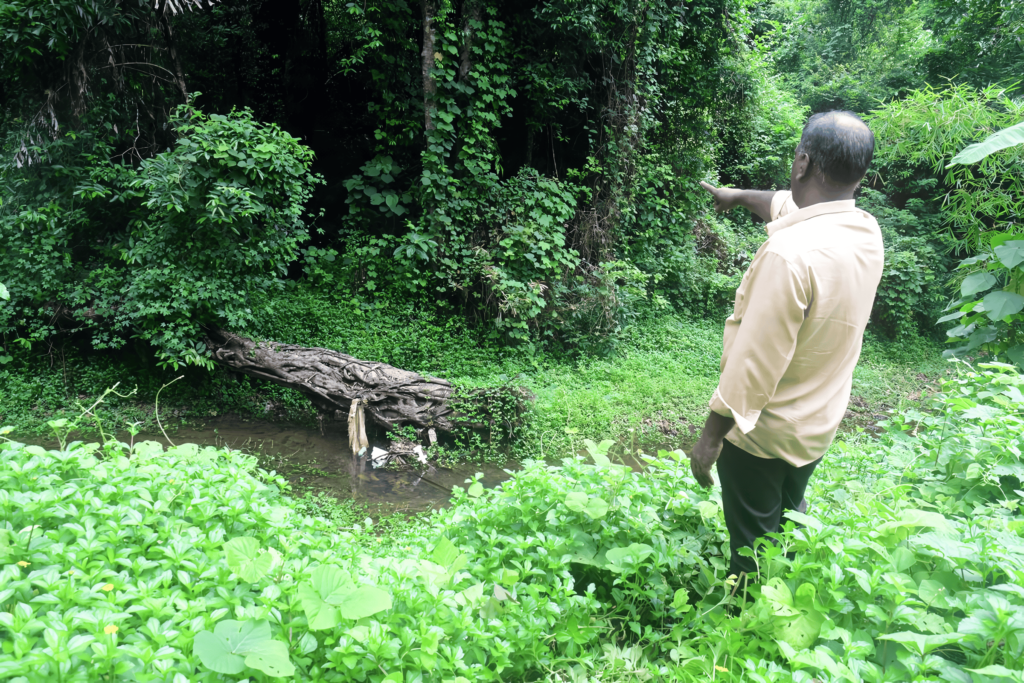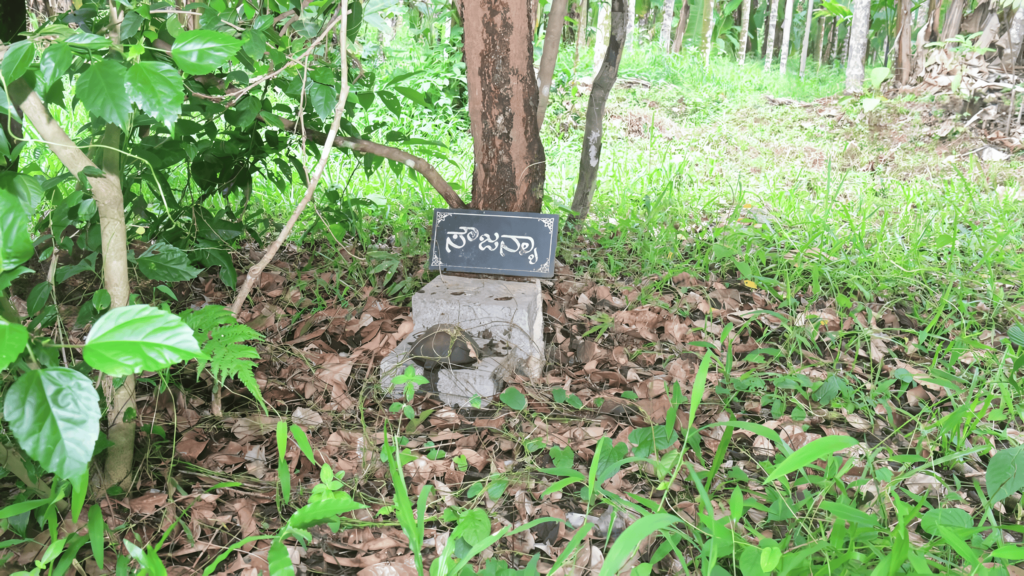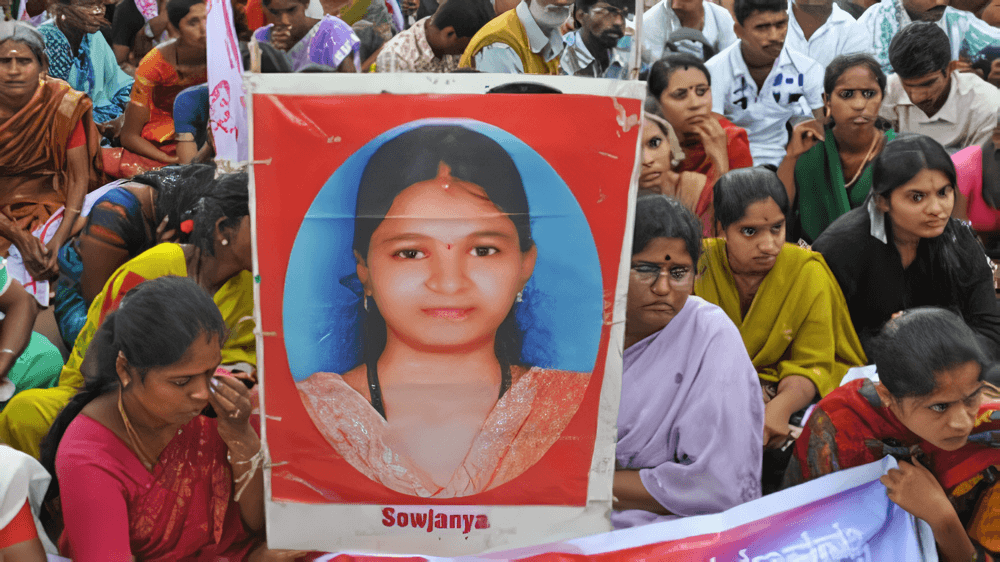By Srinivas Rayappa
Content warning: This article contains descriptions of sexual assault, murder, and investigative details that readers may find disturbing.
A Young Life Extinguished
On October 9, 2012, as rain fell steadily over the temple town of Dharmasthala in Karnataka’s Dakshina Kannada district, devout 17-year-old Soujanya attended her regular classes and then stayed for special examinations at SDM College in Ujire. The innocent second-year pre-university student had dedicated herself to a full day of academic commitments while observing a religious fast—a reflection of the discipline and devotion that those who loved her would remember most. At approximately 4:15 pm, unaware that this ordinary Tuesday would become her last, she bid farewell to her classmates, boarded a bus home, and alighted at Nethravati bathing ghat—less than a kilometer from the renowned Dharmasthala temple where thousands of devotees seek divine intervention daily.
As Soujanya stepped off the bus, two of her uncles—one a jeep driver who regularly ferried passengers to the temple—spotted her and waved warmly. They offered her a ride home, but she politely declined, explaining that she was hungry and preferred to walk. It was a decision that would haunt her family forever.
Soujanya, described by those who knew her as bright and ambitious, began what should have been a short walk toward her home. She never arrived.
The next morning, her body was discovered in a wooded area at Mannasanka, just 25 meters from the main road leading to the temple. She had been raped and strangled, with her college ID card lanyard used as the murder weapon.
In the twelve years since that rainy October evening, Soujanya’s case has transformed from a shocking local crime into something far more complex—a labyrinth of contradictory evidence, allegations of evidence tampering, claims of powerful interests obstructing justice, and a legal process that ultimately failed to identify her killer.
This is not simply the story of an unresolved murder. It is a window into the fault lines of power, justice, and accountability in a region where sacred and secular authority have long been intertwined.
Two Narratives: A Case Divided
From the beginning, the Soujanya case has been characterized by two starkly different narratives.
The official investigation led to the arrest of Santhosh Rao, a man in his early thirties who was apprehended near Bahubali Betta (hillock) two days after the murder. According to police, Santhosh confessed to the crime and led investigators to recover evidence. He was charged with rape and murder.
But a parallel narrative emerged—one championed by Soujanya’s own family, activist Mahesh Thimarodi, former police officer Girish Mattananavar, and other concerned citizens. In this account, Santhosh was merely a convenient scapegoat, framed to protect powerful interests connected to the Dharmasthala temple management. They pointed to numerous inconsistencies in the investigation and alleged a systematic effort to misdirect the case.
The division between these narratives would only deepen over time, eventually exposing troubling questions about how the case was handled from its earliest hours.
The Initial Investigation: Critical Questions Emerge
The Discovery Timeline
When Soujanya failed to return home on the evening of October 9, her worried family initiated a search. According to their accounts, between 800-1000 people participated, thoroughly covering the very area where her body would later be found.
This raised an immediate question: How could so many searchers miss finding her body in the very location where it was discovered the next morning?
The family came to believe that Soujanya was assaulted and killed elsewhere, with her body deliberately placed at the discovery site afterward—a theory based on several anomalies they observed.
Environmental Contradictions and Multiple Perpetrator Evidence
Dharmasthala’s geography—dense forests, rolling mountains, and scattered houses connected by forest paths—becomes particularly challenging during the region’s heavy rainfall, which often drizzles persistently throughout the day. On this occasion, the downpour had swollen a nearby stream to nearly 10 feet deep with rapidly flowing water.

The family questioned how any single person, including Santhosh Rao, could have carried out this crime alone at the location where her body was found. The evidence painted a chilling picture of coordinated brutality: First, it would have been humanly impossible for one person to carry Soujanya’s body across the treacherous, swollen stream. Second, multiple severe wound injuries on her arms and legs indicated that someone had forcibly held her while another person committed the assault. Third, the presence of undigested food in her stomach suggested that someone had gone to fetch food for her—would they have left her unattended during such a mission? Fourth, if Santhosh Rao had indeed been the perpetrator, what explained his presence in the area for two full days after the crime, remaining conspicuously near the scene rather than fleeing?
The irony was stark—while residents often traverse isolated forest paths to reach their scattered homes, Soujanya’s body was found mere meters from a main road that sees constant traffic from the lakhs of pilgrims who visit this land of righteousness and piety daily.
The Dry Schoolbag Mystery
Perhaps most perplexing was the condition of Soujanya’s belongings. Despite the incessant rain and her body being wet, her school bag—which had visible bloodstains—was found completely dry at the crime scene. Even more mysteriously, though the bag’s zipper was open, the books inside remained dry.
How could this be possible if the bag had been at the scene throughout the rainy period? More troublingly, the bloodstains on the bag were reportedly never collected by forensic experts or sent for laboratory testing.

The Fasting Discrepancy
Soujanya’s family maintained she had been fasting on that day due to “Hosa Akki Oota”—meaning “new rice meal”—a harvest festival celebrated in the coastal Karnataka region, particularly by Tulu speakers, to mark the first harvest of the new rice crop. Multiple witnesses confirmed her commitment to this fast: her mother verified she had observed the fast throughout the day, a classmate recalled offering her food that afternoon which she politely declined to avoid breaking her fast, and her uncles understood her eagerness to reach home quickly as she was hungry from fasting and looking forward to a delicious meal. Yet the postmortem report indicated undigested food in her stomach, suggesting she had consumed food approximately six hours prior to her death.
This led to speculation that she might have been abducted around 4:30 PM, held captive, brutally raped, fed, and later killed elsewhere before her body was disposed of at the discovery site.
Allegations of Evidence Tampering
As the investigation progressed, Soujanya’s family began raising increasingly serious allegations about the handling of evidence.
The Missing Page Incident
The family alleges that on the night of Soujanya’s disappearance, a police constable visited their home and began examining her study materials. According to their account, he was observed cutting a page containing two telephone numbers from one of her books and pocketing it. When questioned, he claimed that the numbers were needed for investigation.
The next day, the family claims this same piece of paper was found near Soujanya’s body—suggesting potential planting of evidence.
Forensic Sample Mishandling
Among the most disturbing allegations involves claims that mud was deliberately inserted into Soujanya’s vagina, potentially to eliminate DNA evidence that could identify the perpetrator(s).
The family alleges that vaginal swab samples were only sent to the Forensic Science Laboratory (FSL) after 10 days, despite protocol requiring submission within 72 hours. By then, fungal growth had reportedly compromised the samples, resulting in their rejection—eliminating a potentially crucial source of DNA evidence.
The Postmortem Questions
Dr. Adam, who conducted the postmortem, reportedly told investigators there was insufficient lighting and poor visibility during the examination. The family questions why authorities would proceed with such a critical procedure under suboptimal conditions, particularly when the results would be essential to the investigation.
The Undergarment Test
Soujanya’s undergarments were not found at the crime scene. Later, when police requested an undergarment from the family for “identification purposes,” the family secretly marked it by stitching a distinctive thread to it before handing it over. They allege that this very same marked undergarment was subsequently presented in court as evidence that had been recovered from the crime scene—suggesting it had been planted as evidence.
Intimidation of the Grieving Mother
In a particularly cruel twist, Soujanya’s mother was hospitalized after her daughter’s body was discovered. She later claimed that deliberate attempts were made to label her as mentally unstable, seemingly in response to her unwavering commitment to seeking justice for her daughter through continued protests and public advocacy.
The Accused: Santhosh Rao
The man at the center of the case, Santhosh Rao, was described at various points as a vagrant, a mentally disturbed individual, and a karate black belt with considerable physical strength. This characterization, however, painted an incomplete picture of a complex individual.
In reality, Santhosh worked at a hotel in Sringeri and was known as a deeply pious person who regularly visited both Dharmasthala and Kukke Subramanya temples—sacred sites located 54 kilometers apart. Remarkably, he had visited Kukke Subramanya temple just the day before arriving in Dharmasthala, following his customary spiritual routine.
Santhosh was indeed highly athletic and held a black belt in karate, demonstrating considerable physical prowess. However, his life had taken a troubling turn after he sustained a massive blow during a competitive fight, an incident that seemed to trigger some mental instability and altered behavior patterns.
His family background spoke to respectability and community standing. Santhosh’s father was a highly regarded teacher in their locality, known for having guided numerous students throughout his distinguished career. The accusations against Santhosh would devastatingly impact the entire family—his brothers found themselves unable to marry, their prospects destroyed by the social stigma of the case.
He was apprehended on October 11, 2012, near Bahubali Betta when three individuals—Mallik Jain, Dheeraj Jain, and Uday Jain—encountered him sitting alone in the dark. By some accounts, when someone shouted “Police, Police,” Santhosh fled, leading to his capture by local residents who reportedly beat and assaulted him before handing him over to authorities.
Medical Examination and Controversy
Medical examination revealed multiple injuries on Santhosh’s body, creating an immediate investigative challenge—distinguishing between injuries inflicted by the mob during his capture and potential defensive wounds that might have been inflicted by Soujanya during the attack. Complicating matters further, multiple doctors provided conflicting theories about the nature, severity, and timing of Santhosh’s injuries, making it virtually impossible to establish a clear timeline of when various wounds were sustained.
Two significant medical factors would later become central to the case:
- The phimosis condition: Medical examination revealed Santhosh suffered from phimosis, a condition where the foreskin cannot be fully retracted over the head of the penis, which can make penetrative sexual intercourse physically difficult or impossible.
- Nail scratch allegations: While doctors noted what appeared to be nail scratch marks on Santhosh’s body, forensic testing of Soujanya’s nail clippings found no skin tissues or blood matching Santhosh—a critical contradiction.
Allegations of Police Torture
Santhosh’s father—the respected teacher—alleged his son was brutally tortured in police custody to extract a confession, claiming to have personally witnessed this mistreatment. His testimony carried particular weight given his standing in the community and reputation for integrity. Some protestors made even more extreme allegations about specific torture methods, though no evidence substantiated these particular claims.
Wider Context: Power and Land in Dharmasthala
As the case developed, allegations expanded beyond the specific crime to encompass broader claims about power dynamics in the region—particularly regarding the Dharmasthala temple management.
A Pattern of Mysterious Deaths
Dharmasthala’s recent history has been marked by several deaths of unknown individuals under mysterious circumstances over the past two decades, most of which have never been adequately investigated or solved. Temple authorities and administration have consistently attributed these incidents to suicides, claiming that people consider the holy place an auspicious location to end their lives and attain moksha (spiritual liberation). However, families and activists have questioned this convenient explanation, suggesting a pattern of unexplained deaths that demands closer scrutiny.
Financial Influence Allegations
The Dharmasthala temple reportedly generates substantial revenue through devotee donations, with unverified claims suggesting annual figures of around ₹400 crore. Soujanya’s family alleged that a significant portion of these funds was being lent to local residents at extremely high interest rates outside of regulatory frameworks, creating financial leverage over the community.
Land Acquisition Claims
Perhaps most troubling were allegations connecting Soujanya’s case to claims of aggressive land acquisition practices. The family and supporters suggested that sexual violence and murder were potentially being used as intimidation tactics to facilitate property acquisition.
They pointed to another disturbing case—the murder of a mahout and his sister in the same region just days before Soujanya’s death. These victims had allegedly refused to sell their property near Dharmasthala despite harassment. This case also reportedly reached a dead end due to “lack of evidence” and involved the same investigating officer as Soujanya’s case.
The Mistaken Identity Theory
A particularly disturbing alternative theory suggested that Soujanya may not have been the intended target, but rather a girl named Varsha, whose family owned property reportedly coveted by land acquisition interests.
Counter-Arguments and Alternative Explanations
While the allegations paint a troubling picture, there are counter-arguments to several key claims:
- Footwear controversy: While the family claimed only one piece of Soujanya’s footwear was found at the scene (suggesting relocation of the body), court records indicated a complete “pair” was discovered.
- CCTV evidence destruction: Counter to claims that the bus stand was hastily demolished to destroy CCTV evidence, critics argued either that no bus stand existed at the specified location or that the existing structure was only demolished years later as part of planned infrastructure development. It should be noted that both the bus stand and Prakruti Chikitsalaya had CCTV cameras, though only the bus stand was allegedly demolished.
- Environmental limitations: Regarding allegations that dog squads and fingerprint experts were deliberately not used, critics argued that adverse environmental conditions genuinely prevented their deployment.
The Three Additional Suspects
The case took another turn when three additional individuals—Mallik Jain, Dheeraj Jain, and Uday Jain—came under scrutiny through allegations from Soujanya’s family. These were the same individuals who had initially reported Santhosh’s suspicious presence at Bahubali Betta.
In February 2017, these three men held a press conference denying any involvement, explaining they had undergone extensive testing including DNA tests, blood tests, brain mapping, and lie detector tests. They expressed confusion about how they became connected to the case and willingness to undergo further testing to prove their innocence.
The Path to Acquittal: Legal Proceedings
Despite the conflicting narratives and allegations, the case against Santhosh Rao proceeded through the legal system for over a decade before reaching its conclusion.
The Trial Court’s Judgment (June 16, 2023)
On June 16, 2023, the 50th Additional City and Sessions Judge, Children’s Court (Special), Bengaluru, acquitted Santhosh Rao of all charges, finding there was absolutely no evidence connecting him to the alleged crime. Following his acquittal, Santhosh Rao filed a writ petition in the High Court seeking ₹50 lakh compensation for malicious prosecution. The court identified numerous evidentiary problems:
- DNA evidence inconsistencies: While the FSL report found three hair strands in Santhosh’s panche (a traditional piece of cloth worn in Dakshina Kannada) that matched his DNA and three from another unidentified male, no seminal stains or hairs from the victim were found on his clothes.
- Soil evidence contradiction: Soil was found in both the victim’s clothes and her vaginal swab, but no soil was found on the accused’s clothing.
- Medical inconsistencies: The victim’s nail clippings contained no skin tissues or blood from the accused, despite alleged defensive scratches. Notably, Soujanya’s nails were very well trimmed, making it nearly impossible for her to scratch someone effectively.
- Investigative failures: If the accused had indeed shown investigators the crime scene as claimed, experts should have been called to collect evidence, but no such process occurred.
High Court Confirmation (August 30, 2024)
The Central Bureau of Investigation appealed the acquittal to the Karnataka High Court. On August 30, 2024, a Division Bench comprising Justice Sreenivas Harish Kumar and Justice J.M. Khazi upheld the acquittal in a detailed judgment.
The High Court emphasized that “since the girl was physically well built, the possibility of a single man like the accused having forcible intercourse was remote and there was possibility of involvement of more than one person.”
The court’s conclusion was unequivocal: “Therefore the conclusion is that no circumstance is proved by the prosecution. The trial court has properly discussed the evidence.”
Aftermath and Unanswered Questions
In January 2025, Soujanya’s father, Chandappa Gowda, passed away after a prolonged battle with ulcers and kidney complications, conditions exacerbated by the trauma and relentless stress he endured following his daughter’s death. He died never seeing resolution in his daughter’s case, carrying the weight of unanswered questions to his grave. Prior to his death, he had filed a writ petition seeking a fresh investigation and action against officials responsible for the botched investigation.
The Karnataka High Court rejected this plea in April 2024, stating that “no purpose would be served even if reinvestigation is permitted.”
Notably, the CBI court in 2023 had indicated that “this is a fit case to be placed before the acquittal committee for initiating action against the erring officials.” It remains unclear whether this recommendation was ever implemented.
The Officers: Careers After the Case
The aftermath of the investigation raises troubling questions about accountability:
• Circle Inspector Bhaskar Rai, who admitted in court that he failed to collect crucial CCTV footage and expert reports on Santhosh’s injuries, was later promoted to Deputy Superintendent of Police (DySP) rank.
• Sub-Inspector Yogesh Kumar Naik, who testified that CCTV footage from key locations was never collected, was transferred out of Belthangady. Later, when posted in Bengaluru, he was allegedly involved in a kidnapping case and suspended.
Despite these admissions of investigative failures and the Police Act’s provisions for disciplining officers who neglect their duties, questions remain about whether appropriate accountability measures were ever implemented.
A Family’s Unending Search for Truth
For Soujanya’s family, the acquittal of Santhosh Rao was not a setback but confirmation of what they had maintained throughout—that he was not responsible for their daughter’s death.
Their fight has never been to secure Santhosh’s conviction, but rather to uncover what they believe is the truth about who killed their daughter and why the investigation took the direction it did.
The case continues to be championed by activist Mahesh Thimarodi, who has led protests extending from Karnataka to Delhi, refusing to allow public memory of Soujanya’s case to fade. The “Justice for Soujanya” movement has maintained remarkable persistence, with protests occurring regularly across Karnataka since her death twelve years ago. Different organizations have consistently organized commemorative events on both her birth and death anniversaries, ensuring that her story remains alive in public consciousness and that pressure for justice never completely disappears.
The Shadow That Remains
The Soujanya case stands as a troubling example of how justice can remain elusive even after the legal system has run its course. While the courts have definitively ruled on Santhosh Rao’s innocence, the question of who killed Soujanya remains unanswered.
Interestingly, the number of unnatural deaths at Dharmasthala has significantly declined since Soujanya’s rape and murder and the sustained protests that followed. This development suggests that public scrutiny and persistent activism may have had a meaningful impact on whatever factors were contributing to the mysterious deaths in the region.
More broadly, the case raises profound questions about power, accountability, and justice in India:
- How can families ensure thorough investigations when they suspect powerful interests may be involved?
- What accountability mechanisms exist when investigations go awry through negligence or deliberate misconduct?
- What happens to public trust when cases with significant evidentiary problems proceed through years of prosecution only to collapse entirely at trial?
For the pilgrimage town of Dharmasthala, known as a spiritual center where devotees seek divine justice and intervention, the unresolved case casts a long shadow—a reminder that earthly justice sometimes remains frustratingly beyond reach.
Note: This article has been written based on court records, media reports, and statements from various parties involved in the case. Some allegations remain disputed, and the article presents multiple perspectives on this complex case.


